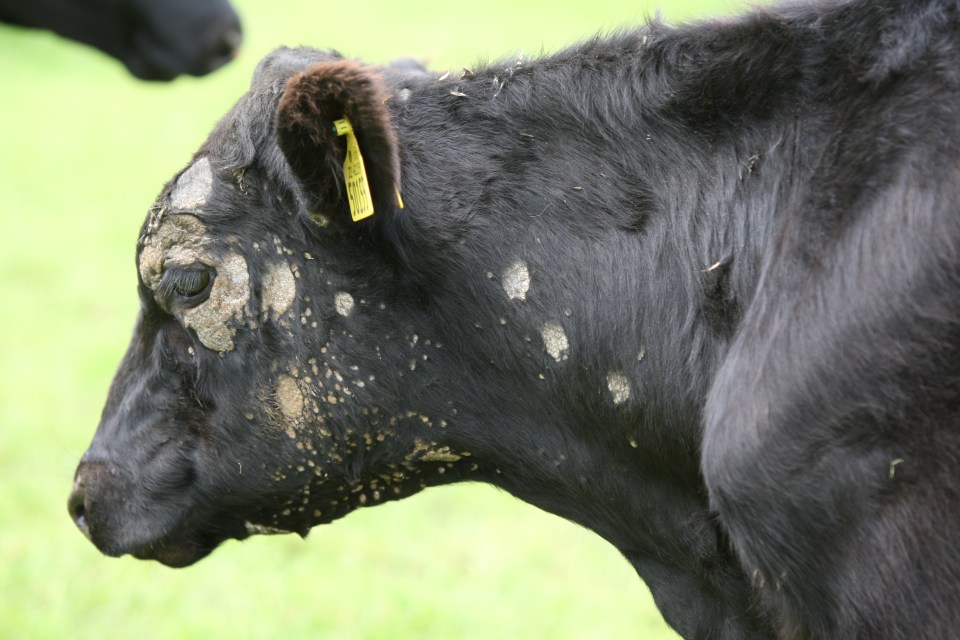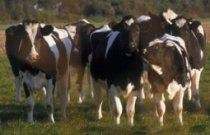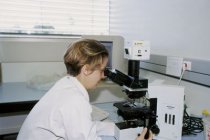
Ringworm
A page about ringworm in cattle, its causes, clinical signs, diagnosis, treatment and control.

Information
Ringworm is a fungal infection of the skin with a worldwide distribution. The disease is of significant economic consequence to the farmer since growth rates are affected in the active stage of infection and the disease causes hide damage.
Aetiology
The infection of hair and skin keratin with the dermatophytes Trichophyton verrucosum (95% of cases), and less commonly Tricophyton mentagrophytes, cause lesions commonly referred to as ringworm. Trichophyton verrucosum is responsible for more than 90% of the cases.
Epidemiology
The infection is spread primarily through direct contact between animals, with clinically infected animals being the greatest source of infection. The spores of ringworm fungi survive many months and in some cases years in the farm environment and may be transmitted either by fomites (brushes, gates, feed carts…) or by asymptomatic carriers to susceptible hosts. There is an increased risk of outbreaks during building work, with a much higher number of spores being released into the air.
Housing is important in the spread. Lesions are seen primarily around the head and neck of cattle, this is due to rubbing the head against fences and pushing through feeding bars. A natural outbreak will generally affect only younger animals, though older animals which have not previously had contact with the dermatophyte can also easily be affected due to the lack of natural immunity. The disease is more common in cooler countries and may be influenced by humidity. The incubation period of the disease is generally considered to be approximately one week although four weeks has been suggested as the period in some outbreaks.
Factors that influence susceptibility of an animal to dermatophyte infection are:
Age of the animal: Young animals are by far more susceptible to infection. This is probably related to lack of prior exposure/infection and thus no immunity. Adult cattle are also quite frequently affected. The overall incidence of ringworm based on evidence of hide damage in a number of European countries appears to be around 10% of cattle.
Crowding together young animals
Factors that decrease resistance to infection: Poor nutrition, concurrent disease, previous use of immunosuppressive drugs.
Environmental factors may play a role, since the prevalence of the disease is increased in hot, humid climates. Calves kept indoors or exposed to foggy weather with little or no sunlight have an increased incidence.
Other species may also be infected, including horses, sheep and also man in whom it may cause serious skin lesions. The zoonotic implications are serious, and once ringworm is known to be on farm all precautions must be taken to avoid spread to farm staff and especially children.
Clinical Signs
- Skin lesions
- Pruritus
- Hair loss
- Poor growth
The clinical manifestation varies in terms of the number and size of affected sites, but the head and neck areas are most susceptible. In addition to the multifocal nature of the disease, the individual lesions usually vary considerably in size. The primary changes that are observed clinically are alopecia, scaling and crusting. Lesions are characteristically greyish-white and have an ash-like surface. Their outline is circular and they are slightly raised due to the accumulation of many layers of scale and the swelling of tissues beneath due to a moderate inflammatory reaction. The size of lesions varies, 3-5 cm diameter being common; in the more severely affected animals lesions become confluent to form extensive areas of infection.
The degree of associated pruritus varies, but pruritus is usually either mild or absent. In most cases, ringworm is a self-limiting disease, with the duration of infection ranging from 1 to 4 months. The spontaneous regression is probably at least partly related to the development of immunity. The clinical changes clear from the centre outwards, leaving lasting skin damage in the form of scar tissue and collagen deposits.

Diagnosis
Diagnosis is made on the clinical signs of the classic lesions of ringworm. The asbestos like lesions are very typical for cattle. A conclusive diagnosis requires mycological examination in the form of direct microscopy and culture.
Collection of samples
For the collection of samples there are two procedures:
By forceps, epilation of hair from areas of active infection.
Scrapings of crust, hair and scale using a scalpel blade.
Using either of these procedures the material obtained is collected in a paper envelope, sealed and labeled for transmission to the laboratory.
If culture is contemplated, swabbing the area with 70% alcohol prior to collection of material may reduce contaminants in the specimen.
Laboratory tests
Direct microscopy: Microscopic examination reveals the constituents of the fungi on the skin and hair fragments
Culture: definite diagnosis of the species of fungus requires the use of culture techniques. Culture mediums are Sabouraud’s agar, mycobiotic agar and dermatophyte test medium (DTM). In order to arrive at a conclusive answer culture time may need to be extended for as long as three weeks.
Control
The ringworm fungus produces spores that are resistant to ordinary cleaning, and need heavy disinfection to clear them.
They last over a year so can be present long after the infection in the animals have gone, and even after the animals themselves have gone.
Farm premises must be disinfected between batches of calves and wooden surfaces treated with creosote ( tar-based wood paint)
Animals should be handled with gloves.
Bought-in calves or other animals should be screened for skin lesions on arrival and separated and treated until all lesions have gone. Spores may still be present.
Potentially in-contact animals should be vaccinated since spread is likely on subsequent mixing.
Vaccination
Prophylaxis is by vaccination and environmental disinfection. Disinfectants require high concentrations of chlorine, up to 4%.
Treatment
Treatment of ringworm in cattle faces two major obstacles:
The difficulty of eliminating the organism from the environment.
The number of animals that need to be treated.
Only one product is available licensed for treatment containing Enilconazole.
- A member of the azole family
- Needs 2 or 3 weekly applications
- Kills the surface infection but not very sporicidal
- Applied as an emulsified wash
- Penetrates into hair follicles, but unable to do so if a lot of surface encrustation exists that prevents soaking of the deep follicles
